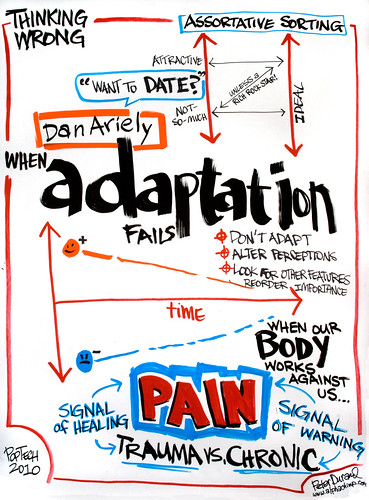 Adaptation is the basic idea that we get used to stuff and interpret signals. Behavioral economist Dan Ariely explores how these types of signals relate to pain and social adaptation. How does our previous exposure to pain alter how we experience it now? How is it that we all appreciate the pinnacle of beauty in the same way, but we’re drawn to partners with a level of attractiveness similar to our own?
Adaptation is the basic idea that we get used to stuff and interpret signals. Behavioral economist Dan Ariely explores how these types of signals relate to pain and social adaptation. How does our previous exposure to pain alter how we experience it now? How is it that we all appreciate the pinnacle of beauty in the same way, but we’re drawn to partners with a level of attractiveness similar to our own?
From Emily Spivack the PopTech Blog:
Dan Ariely just sent us one of his signature videos as an addendum to the concept of adaptation he’d introduced during his PopTech talk this past October. Ariely had spoken candidly about adaptation to pain from his own experience and how severe injuries increase one’s pain threshold. He also shared results from studies he conducted on social adaptation as it relates to assortative mating, or, to put it bluntly, figuring out who’s within someone’s league and who isn’t when it comes to meeting a significant other.
Adaptation comes in another form – professional adaptation. Ariely anecdotally explained that he made a number of small decisions, which led him on his current career path, including clumsily killing a slew of lab rats before he realized that his hands weren’t cut out for physiology. Adaptation is the process by which we maneuver around an environment to figure out what works best for us, he concluded.
If you’re a Dan Ariely fan like we are, why not consider checking out his SXSW panel on Tuesday, March 15 with Sarah Szalavitz, Flexible Morality of User Engagement & User Behavior, or participating in a 15 minute experiment in which the results will be showcased during the panel?
